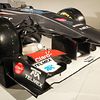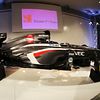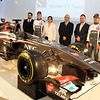Sauber C32 launch - technical analysis
Despite this being the last year with the current engines, requiring a major design change for 2014, Sauber have pulled out all stops to produce a car that is largely different from its predecessor and successful Sauber C31. The team have tried to "improve on the strenghts of the C32" while attempting to eliminate "its few weaknesses".
Apart from it being all grey, the team have obviously put a lot of effort into the sidepod area, where radiator and component positioning has changed to ensure a better airflow to the rear end of the car, attempting to extract more rear downforce out of the diffuser and the rear wing assembly.
The team's chief designer, Matt Morris, explained at the launch: “The airflow in this area has a major influence over everything that happens at the rear of the car,” said Morris, offering a glimpse into the team’s thinking. An extremely slim rear end was high up the engineers’ list of priorities. One of the key aspects here is the arrangement of the radiators, which is very different from that in the C31."
This means the sidepod inlets have changed while the sidepod panel is now connected with the sidepod's upper outmost corner by a very elegant arch. The specific design of the latter element is important for exhaust flow, which is now expected to be different since the team abandoned its Red Bull style exhaust ramp in favour of the McLaren solution, with a narrow rear end of the sidepod and a bulge sticking out to house the exhaust pipe.
Again, to optimise exhaust flow, the team have redesigned the entire rear suspension just like Ferrari reported: "The rear suspension is a totally new development. Although it still works according to the pullrod principle, its layout has been designed to better interact with the airflow around the rear of the car, while further improving the tyre management."
The front of the car has changed less dramatically, with a front wing at the launch that is still very similar to what as seen at the end of 2012 on the Sauber C31. The nose on the other hand is similar although it adds two humps on each side of the cone, ahead of the step. Indeed, the stepped nose was retained from last year, including the S-duct, a feature unique to Sauber that feeds air from the boundary layer underneath the nose to the upper surface.
Internally, the car’s KERS (Kinetic Energy Recovery System), engine and gearbox are supplied by Ferrari, as before. The KERS is based on last year’s version, but its weight and packaging volume have been optimised.
And just like with its drivetrain supplier, one of the high priorities at Sauber was a reduction of the car's overall weight, to allow a better distribution of the ballast, while retaining its structural requirements and mechanical setup flexibility. “My colleagues have done an excellent job here, and we have even exceeded our original targets”, praised Morris.
There was also potential for improvement in how the tyres are used in qualifying, as Morris explained: “Our car looked after its tyres very well during races last year. However, we had problems now and again when it came to getting the maximum out of them in qualifying. We’ve looked at this phenomenon closely and made the required adjustments.”
Like last year, the Sauber F1 Team will use a basic version of the car for its rollout event and introduce a major update before the first race of the season.
Steven De Groote






